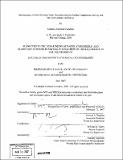| dc.contributor.advisor | Konrad A. Hughen and William B. Curry. | en_US |
| dc.contributor.author | Goodkin, Nathalie Fairbank | en_US |
| dc.contributor.other | Woods Hole Oceanographic Institution. | en_US |
| dc.date.accessioned | 2008-03-27T18:31:48Z | |
| dc.date.available | 2008-03-27T18:31:48Z | |
| dc.date.copyright | 2007 | en_US |
| dc.date.issued | 2007 | en_US |
| dc.identifier.uri | http://hdl.handle.net/1721.1/40969 | |
| dc.description | Thesis (Ph. D.)--Joint Program in Chemical Oceanography (Massachusetts Institute of Technology, Dept. of Earth, Atmospheric, and Planetary Sciences; and the Woods Hole Oceanographic Institution), 2007. | en_US |
| dc.description | Includes bibliographical references. | en_US |
| dc.description.abstract | A 225-year old coral from the south shore of Bermuda (64°W, 320N) provides a record of decadal-to-centennial scale climate variability. The coral was collected live, and sub-annual density bands seen in x-radiographs delineate cold and warm seasons allowing for precise dating. Coral skeletons incorporate strontium (Sr) and calcium (Ca) in relative proportions inversely to the sea surface temperature (SST) in which the skeleton is secreted. [Delta]180 of the coral skeleton changes based on both temperature and the [delta]180 of sea water ([delta]Ow), and 6Ow is proportional to sea surface salinity (SSS). Understanding long-term climate variability requires the reconstruction of key climate parameters, such as sea surface temperature (SST) and salinity, in records extending beyond the relatively short instrumental period. The high accretion rates, longevity, and skeletal growth bands found in coral skeletons make them an ideal resource for well-dated, seasonal climate reconstructions. Growing between 2 and 6 mm/year and reaching more than im in length, slow-growing corals provide multi-century records from one colony. Additionally, unlike the fast growing (10-20 mm/year) species Porites, slow-growing species are generally found in both tropical and sub-tropical locations greatly expanding the geographical location of these records. A high resolution record (HRR, ~11 samples per year) was drilled for the entire length of the coral record (218 years). Samples were split and Sr/Ca, [delta]180, and [delta]13C were measured for each sample. Sr/Ca was used to reconstruct winter time and mean-annual SST. Oxygen isotopic measurements were used to determine directional salinity changes, in conjunction with Sr/Ca based SST reconstructions. | en_US |
| dc.description.abstract | (cont.) Winter-time and mean annual SSTs show SSTs -1.5 'C colder during the end of the Little Ice Age (LIA) relative to today. Simultaneously, SSS is fresher during that time. Sr/Ca based climate reconstructions from coral skeletons have been met with some skepticism because some reconstructions show temperature changes back in time that are 2-4 times greater than the reconstructions of other marine proxies. In this study, we show that when using bulk-sampled, slow-growing corals, two steps are critical to producing accurate reconstructions: 1) incorporating growth rate into multi-variant regressions with SST and Sr/Ca and 2) using multiple colonies that grew at the same time with varying average growth rates and Sr/Ca. Application of these novel methods over the period of the instrumental record from Hydrostation S (monthly since 1954, 32°10'N, 64°30'W) reduces the root mean square of the residuals between the reconstructed SST and the instrumental SST by as much as 1.52'C to 0.460C for three coral colonies. Winter-time SSTs at Bermuda are correlated to phases of the North Atlantic Oscillation (NAO), a meridional oscillation in atmospheric mass. Much uncertainty remains about the relationship between the NAO and the ocean, and one critical outstanding question is whether anthropogenic changes are perturbing the system. Using winter Sr/Ca as a proxy for temperature, we show strong coherence to the NAO at multi-decadal and inter-annual frequencies. These coral records show significant changes in variance in the NAO during the late 20th century compared to the cooler LIA, but limited changes in the mean phase (positive or negative) of the NAO, implying that climate change may be pushing the NAO to extremes but not to a new mean position. | en_US |
| dc.description.statementofresponsibility | by Nathalie Fairbank Goodkin. | en_US |
| dc.format.extent | 281 p. | en_US |
| dc.language.iso | eng | en_US |
| dc.publisher | Massachusetts Institute of Technology | en_US |
| dc.rights | M.I.T. theses are protected by
copyright. They may be viewed from this source for any purpose, but
reproduction or distribution in any format is prohibited without written
permission. See provided URL for inquiries about permission. | en_US |
| dc.rights.uri | http://dspace.mit.edu/handle/1721.1/7582 | en_US |
| dc.subject | Earth, Atmospheric, and Planetary Sciences. | en_US |
| dc.subject | Joint Program in Chemical Oceanography. | en_US |
| dc.subject | Woods Hole Oceanographic Institution. | en_US |
| dc.subject.lcsh | Climatic changes | en_US |
| dc.subject.lcsh | Corals | en_US |
| dc.title | Geochemistry of slow-growing corals : reconstructing sea surface temperature, salinity and the North Atlantic Oscillation | en_US |
| dc.type | Thesis | en_US |
| dc.description.degree | Ph.D. | en_US |
| dc.contributor.department | Joint Program in Chemical Oceanography | en_US |
| dc.contributor.department | Woods Hole Oceanographic Institution | en_US |
| dc.contributor.department | Massachusetts Institute of Technology. Department of Earth, Atmospheric, and Planetary Sciences | |
| dc.identifier.oclc | 213289388 | en_US |
